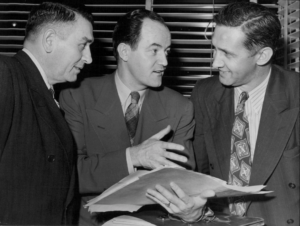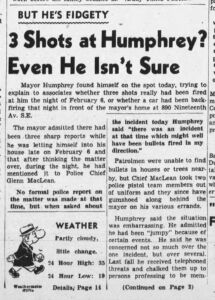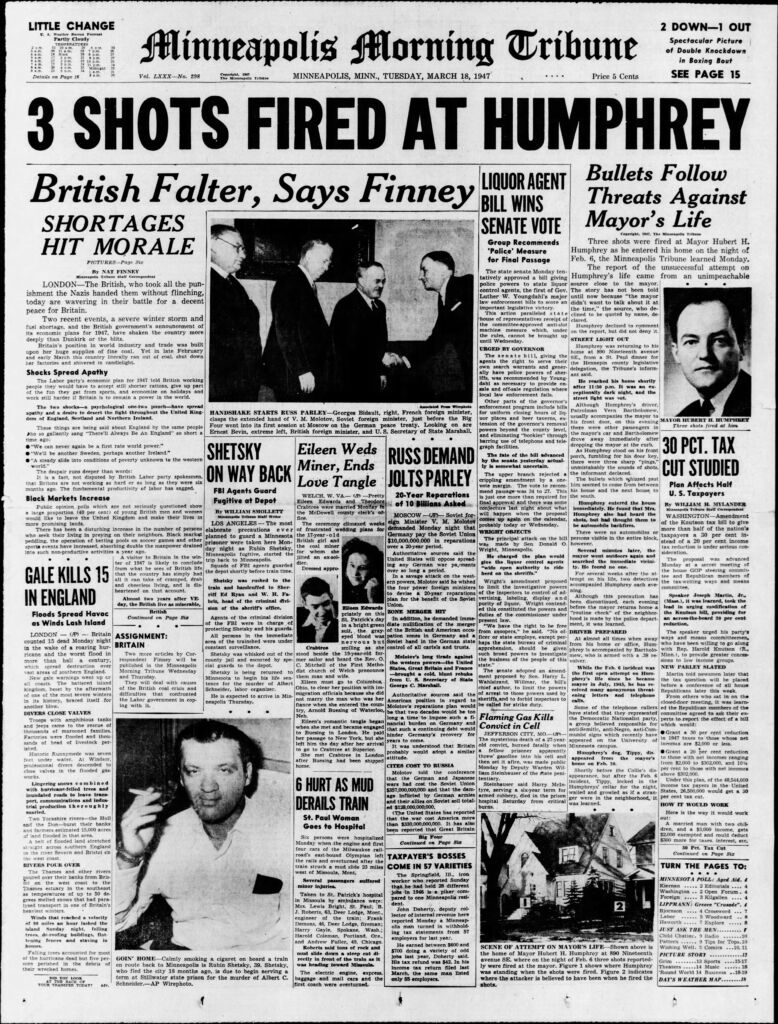This article was originally published in Hennepin History Magazine, 2023, Vol. 82, No. 1
by Charlie Maguire
 Returning home from a dinner on February 6, 1947, Mayor Hubert H. Humphrey asked armed police chauffeur Vern Bartholomew to pull to the curb in front of his modest but distinctive looking home in a student neighborhood near the University of Minnesota. In order to save time for his fellow passengers, Hennepin County aldermen, Humphrey waved off Bartholomew’s offer to walk him to the front door.
Returning home from a dinner on February 6, 1947, Mayor Hubert H. Humphrey asked armed police chauffeur Vern Bartholomew to pull to the curb in front of his modest but distinctive looking home in a student neighborhood near the University of Minnesota. In order to save time for his fellow passengers, Hennepin County aldermen, Humphrey waved off Bartholomew’s offer to walk him to the front door.
Armed bodyguards had become common for Minneapolis mayors. Their homes had been targets for mayhem, like the attempted dynamiting of Mayor George Leach’s home 16 years earlier.2 Even though Humphrey had been elected by the largest margin in city history to that point,3 city officials were wary. Humphrey’s championship of civil rights and for honesty in government had stoked anger in some quarters.
Humphrey walked quickly along the sidewalk and up the steps to his front door. He was eager to see his wife, Muriel, and their two children, Nancy, age eight, and Hubert “Skip” Humphrey Jr., age five.

The night air hovered around 2 below zero. Mature trees hugged the front and sides of Humphrey’s yard, adding to the wintry gloom. Humphrey fumbled hurriedly for his keys. He looked over his shoulder and up the street and noticed a nearby streetlight was out but did not “think it significant.” 4
Suddenly, three shots rang out. Humphrey turned to his right, thinking they came from somewhere between his home and the house next door. “I don’t remember hearing the whizz of the bullets,” Humphrey recalled, “but they may have been fired in my direction. I am pretty certain the noise didn’t come from an automobile backfiring because the reports were too close and too evenly spaced. I got into my house and stayed there.” 5
Remembering the incident 30 years later in his book The Education of a Public Man Humphrey changed his story a little, saying that he “went back outside” after calling the police, “to poke around looking for footprints or the used shells.”6 He did not find anything, nor did police inspector Fred Ahr the next morning. There were no traces of bullet marks in trees or houses, nor evidence of an assailant.
Humphrey may have disturbed the crime scene with any search. Or the weather could have played a factor.
According to historical weather data provided by University of Minnesota professor emeritus Dr. Mark Seeley, about an inch of fresh snow fell between February 6, and February 7, 1947. Total accumulations on the ground were measured at 6 inches on the evening of February 6 and 7 inches the next day. “Even a half inch of snow, plus the combination of blowing and drifting,” Seeley said, “could easily cover up footprints.”7
Humphrey kept the incident under wraps for almost six weeks, describing the shooting when the story broke in the Minneapolis papers on March 18, “as a closed incident.”8 Humphrey stated, “I instructed [police superintendent Glen] MacLean to keep the matter out of regular channels because I wanted to avoid any publicity.” He added, “I’m sorry all this had to come out, it has my youngsters and my parents pretty well stirred up now.”9
Neighbors next door and across the street were interviewed and reported seeing no suspicious persons “loitering about the neighborhood”10 the night
of the shooting.
The night after the shooting, however, the family dog, Tippy, growled at the door, perhaps perceiving a threat. Two weeks later, the collie disappeared.11 Vern Bartholomew faithfully prowled the property for two weeks after the shooting and found no cause for concern.
In 1968, D. J. Leary, a Twin Cities medical consultant who was on Humphrey’s staff when he was vice-president, said about his boss’s attitude toward violent threats: “Humphrey was aware of it. He said he got up every morning and it was like a dull ache in the back of the head . . . after a while you didn’t notice it anymore.”12 Skip Humphrey remembered: “Dad had a bit of a fatalistic point of view. He said if someone wants to get me and give up their life in the process, they’ll do it.”13
No one was ever arrested.
Marcia Pankake moved into the neighborhood later and she recalled that “no one talked about this when we moved on the street, although people still called it the Humphrey House. He was a great old servant of the people.”14
Put on your flashers
The “Humphrey House,” as the neighbors call 890 19th Avenue Southeast, is remarkably the same today as it was in 1947, except for the landscaping between the homes. Please be kind and respectful to the present owners if you drive by.

Charlie Maguire is a songwriter and performer who makes frequent stops to sing or typewrite a story in Hennepin County.
Footnotes
1 “Why would anyone shoot at me?” Hubert Humphrey, The Education of a Public Man: My Life and Politics (Garden City, NY, Doubleday & Company, Inc., First Edition, 1976), 94.
2 George E. Leach, The Personal History of Major George E. Leach, 19511952 (unpublished). Minnesota Historical Society.
3 Reelected by largest margin. en.m.wikipedia.org/wiki/Hubert_Humphrey.
4 “Think it significant.” Hubert Humphrey, The Education of a Public Man: My Life and Politics (Garden City, NY, Doubleday & Company, Inc., First Edition, 1976), 97.
5 “Mayor Gives Version of Shooting,” The Minneapolis Star, March 18, 1947. Star Tribune Archives.
6 “Went back outside.” Hubert Humphrey, The Education of a Public Man: My Life and Politics (Garden City, NY, Doubleday & Company, Inc., First Edition, 1976), 98.
7 A half inch of snow. Dr. Mark Seeley, interview with author.
8 “Mayor Gives Version of Shooting,” The Minneapolis Star, March 18, 1947. Star Tribune Archives.
9 “I instructed MacLean.” Ibid.
10 “Loitering about the neighborhood.” “Bullets Follow Threats Against Mayor’s Life,” Minneapolis Morning Tribune, March 18, 1947. Star Tribune Archives.
11 Collie disappeared. Ibid.
12 “Humphrey was aware.” UPI Archives upi.com/Archives/1984/08/11/Hubert-Humphrey-lived-under-the-threat-of-assassination-around/3127461044800/.
13 “Dad had a bit of a fatalistic point of view.” Ibid.
14 “No one talked about this.” Marcia Pankake, interview with author.
Sources
en.m.wikipedia.org/wiki/Hubert_Humphrey.
americanexperiment.org/magazine/article/the-tragedy-of-hubert-humphrey.
millercenter.org/president/lbjohnson/essays/humphrey-1963-vicepresident.
mnhs.org/library/findaids/00442.xml.
James Lileks, “Minnesota Moment: Shots Fired at Hubert Humphrey.” Star Tribune. March 18, 2018. Star Tribune Archives.
m.startribune.com/minnesota-moment-1947-assassination-attempt-on-hubert-h-humphrey/477003703/?clmob=y&c=n&clmob=y&c=n
